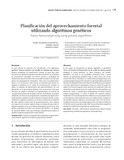Mostrar el registro sencillo del ítem
Planificación del aprovechamiento forestal utilizando algoritmos genéticos
| dc.rights.license | http://creativecommons.org/licenses/by-nc-sa/3.0/ve/ | |
| dc.contributor.author | Quintero M., Maria Alejandra | |
| dc.contributor.author | Ablan Bortone, Magdiel | |
| dc.contributor.author | Jeréz R., Mauricio | |
| dc.date.accessioned | 2011-07-12T21:47:39Z | |
| dc.date.available | 2011-07-12T21:47:39Z | |
| dc.date.issued | 2011-07-12T21:47:39Z | |
| dc.identifier.issn | 0556-6606 | es_VE |
| dc.identifier.uri | http://www.saber.ula.ve/handle/123456789/33485 | |
| dc.description.abstract | En este artículo se presenta una introducción a los algoritmos genéticos, técnica heurística que puede ser utilizada para resolver diversos problemas de planificación forestal. Al igual que otras heurísticas los algoritmos genéticos pueden encontrar, en un tiempo de computación aceptable, una buena solución a problemas de optimización que en muchos casos no pueden resolverse con técnicas clásicas de programación matemática, tales como la programación lineal y sus extensiones. Para ilustrar el potencial que tienen los algoritmos genéticos en el campo de la planificación forestal, se utiliza un ejemplo de planificación del aprovechamiento en una plantación, en el que se desea obtener una secuencia de cortas que minimice los costos y satisfaga los requerimientos de madera de una planta de producción de pulpa. Primero, el problema se resolvió utilizando una técnica de programación matemática (programación entera binaria), mediante la cual se obtuvo la solución óptima. Luego, se diseñó un algoritmo genético y se evaluó su eficiencia en términos del valor objetivo (costo total de aprovechamiento), error relativo con respecto a la solución óptima, eficacia y tiempo de ejecución. El algoritmo genético tuvo un excelente desempeño, presentó un error relativo promedio de 0,24%, una eficacia del 99,76% y un tiempo de ejecución 58,8% menor que el tiempo requerido para resolver el modelo mediante programación entera binaria. | es_VE |
| dc.language.iso | es | es_VE |
| dc.rights | info:eu-repo/semantics/openAccess | |
| dc.subject | Heurísticas | es_VE |
| dc.subject | Programación matemática | es_VE |
| dc.subject | Programación entera binaria | es_VE |
| dc.subject | Algoritmos evolutivos | es_VE |
| dc.subject | Planificación forestal | es_VE |
| dc.title | Planificación del aprovechamiento forestal utilizando algoritmos genéticos | es_VE |
| dc.title.alternative | Forest harvest planning using genetic algorithms | es_VE |
| dc.type | info:eu-repo/semantics/article | |
| dc.description.abstract1 | In this paper, an introduction to genetic algorithms is presented. This is an heuristic technique that can be suited for solving several problems in forest planning. As other heuristics, the genetic algorithms can find, in an acceptable computing time, a good solution to optimization problems that, in many cases, can not be solved with classic techniques of mathematical programming, such as lineal programming and its variants. For illustrating the potential of the Genetic Algorithm (GA) in the field of Forest Planning, an example of harvest planning for a plantation is shown in which the goal is to obtain the harvest sequence that minimize the operation costs and satisfy the wood requirements of a pulp mill. First, the problem was solved by using a mathematical programming technique (binary integer programming), in order to obtain the optimal solution. Thereafter, a GA was designed and its efficiency was assessed in terms of the objective value (total harvest cost), relative error in relation to the optimal solution, efficiency, and execution time. The GA had an excellent performance, showing a relative error of 0,24%, an efficiency of 99,76%, and an execution time 58,8 % lower than that needed for solving the model with integer binary programming. | es_VE |
| dc.description.colacion | 29-39 | es_VE |
| dc.description.email | mariaq@ula.ve | es_VE |
| dc.description.email | mablan@ula.ve | es_VE |
| dc.description.email | mjerez@ula.ve | es_VE |
| dc.description.frecuencia | semestral | es_VE |
| dc.subject.facultad | Facultad de Ciencias Forestales y Ambientales | es_VE |
| dc.subject.keywords | Heuristics | es_VE |
| dc.subject.keywords | Mathematical programming | es_VE |
| dc.subject.keywords | Binary integer programming | es_VE |
| dc.subject.keywords | Evolutionary algorithms | es_VE |
| dc.subject.keywords | Forest planning | es_VE |
| dc.subject.publicacionelectronica | Revista Forestal Venezolana | es_VE |
| dc.subject.seccion | Revista Forestal Venezolana: Artículos | es_VE |
| dc.subject.thematiccategory | Geografía | es_VE |
| dc.subject.thematiccategory | Medio Ambiente | es_VE |
| dc.subject.tipo | Revistas | es_VE |
| dc.type.media | Texto | es_VE |
Ficheros en el ítem
Este ítem aparece en la(s) siguiente(s) colección(ones)
-
Revista Forestal Venezolana - Número 055 - Vol 001
Enero - Junio 2011


